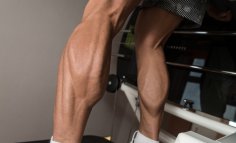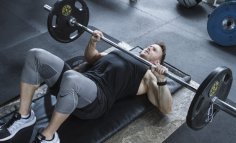Siden han ble nevnt i en annen tråd tidligere i dag, tenkte jeg at jeg kunne legge ut litt informasjon og bilder om denne helt rå idrettsmannen. Like dominerende spiller innenfor basketsporten har det vel kun vært 1 av, og det må ha vært Michael Jordan, men Wilt er mye mindre kjent, noe som er helt ufortjent:
Full Name: Wilton Norman Chamberlain
Born: 8/21/36 in Philadelphia
Died: 10/12/99 in Los Angeles
High School: Overbrook (Philadelphia)
College: Kansas
Drafted by: Philadelphia Warriors (1959)
Transactions: Traded to Philadelphia 76ers,
1/15/65; Traded to Los Angeles Lakers, 7/9/68
Nickname: WIlt the Stilt; The Big Dipper
Height: 7-1; Weight: 275 lbs.
Honors: Elected to Naismith Memorial Basketball Hall of Fame (1978); NBA champion (1967, '72); NBA Finals MVP (1972); NBA MVP (1960, '66, '67, '68); All-NBA First Team (1960, '61, '62, '64, '66, '67, '68); Second Team ('63, '65, '72); All-Defensive First Team (1972, '73); Rookie of Year (1960); One of the 50 Greatest Players in NBA History (1996).
 He was basketball's unstoppable force, the most awesome offensive force the game has ever seen. Asked to name the greatest players ever to play basketball, most fans and aficionados would put Wilt Chamberlain at or near the top of the list.
He was basketball's unstoppable force, the most awesome offensive force the game has ever seen. Asked to name the greatest players ever to play basketball, most fans and aficionados would put Wilt Chamberlain at or near the top of the list.Dominating the game as few players in any sport ever have, Chamberlain seemed capable of scoring and rebounding at will, despite the double- and triple-teams and constant fouling tactics that opposing teams used to try to shut him down.
As Oscar Robertson put it in the Philadelphia Daily News when asked whether Chamberlain was the best ever, "The books don't lie."
The record books are indeed heavy with Chamberlain's accomplishments. He was the only NBA player to score 4,000 points in a season. He set NBA single-game records for most points (100), most consecutive field goals (18) and most rebounds (55). Perhaps his most mind-boggling stat was the 50.4 points per game he averaged during the 1961-62 season--and if not that, then perhaps the 48.5 minutes per game he averaged that same year.
He retired as the all-time in career points with 31,419, which was later surpassed by Kareem Abdul-Jabbar, Karl Malone and Michael Jordan. He is tops in rebounds with 23,924. He led the NBA in scoring seven years in a row. He was the league's top rebounder in 11 of his 14 seasons. And as if to prove that he was not a selfish player, he had the NBA's highest assist total in 1967-68.
But the most outstanding figures are his scoring records; Most games with 50+ points, 118; Most consecutive games with 40+ points, 14; Most consecutive games with 30+ points: 65; Most consecutive games with 20+ points: 126; Highest rookie scoring average: 37.6 ppg; Highest field goal percentage in a season: .727. And with many of these, the player in second place is far behind. His name appears so often in the scoring record books that his name could be the default response any time a question arises concerning a scoring record in the NBA.
During his career, his dominance precipitated many rules changes. These rules changed included widening the lane, instituting offensive goaltending and revising rules governing inbounding the ball and shooting free throws (Chamberlain would leap with the ball from behind the foul line to deposit the ball in the basket).
No other player in NBA history has spawned so many myths nor created such an impact. It's difficult to imagine now, with the seemingly continuing surge of bigger skilled players, the effect of playing against Chamberlain, who was not only taller and stronger than almost anyone he matched up against but remarkably coordinated as well. A track and field star in high school and college, Chamberlain stood 7-1 and was listed at 275 pounds, though he filled out and added more muscle as his career progressed and eventually played at over 300 pounds.
An incident recounted in the Philadelphia Daily News involving Tom Meschery of the Seattle SuperSonics illustrated what it was like to play in the trenches against Chamberlain. Meschery had the ball in the line and put up four fakes before attempting his shot. Chamberlain slapped the ball down. Meschery got it again, faked again, and got it blocked again. Enraged and frustrated, the Seattle player ran up to Chamberlain swinging. As if in a scene from The Three Stooges, Chamberlain put his hand on the 6-6 Meschery's head and let him swing away harmlessly. After the third swing, Chamberlain said, "That's enough," and Meschery stopped.
Chamberlain's power was legendary. Rod Thorn, who has been a player, coach, GM and NBA executive, remembers a fight in which Chamberlain reached down and picked up a fellow player from a pile of bodies as if he were made of feathers. The man was 6-8 and weighed 220 pounds.
Chamberlain was one of the few players of his day who had the sheer strength to block a dunk. In a game against New York in 1968, Walt Bellamy, the Knicks' 6-11, 245-pound center, attempted to dunk on Chamberlain. "Bellamy reared back," one spectator who was there later recalled to the Philadelphia Daily News, "and was slamming the ball down when Wilt put his hand above the top of the rim and knocked the ball off the court. He almost knocked Bellamy off the court, too."
Strength was something Chamberlain developed as a college and professional player. Photographs of him in high school show a slender, agile boy who, at 6-11, towered above the other players. In three varsity seasons at Philadelphia's Overbrook High, starting in 1952-53, Chamberlain led the team to records of 19-2, 19-0, and 18-1. His coaches there took full advantage of his gifts. The team would practice missing free throws so that Chamberlain could grab them and score field goals. At a time when goaltending was legal, Chamberlain sometimes infuriated his teammates by tipping balls in on their way down, even if they were on target.
During his prep years, he scored 2,206 points and had individual games in which he scored 90, 74 and 71 points. In his senior year he averaged 44.5 points. In his 90-point game he scored 60 points in 12 minutes of the second half. "But it's nothing," Chamberlain said in the Philadelphia Inquirer in 1991, "when you consider that the team we were playing against was trying to freeze the ball."
It was also during this time that one of his nicknames, "the Stilt," was coined by a local newspaper writer. Chamberlain detested it, as he did other monikers that called attention to his height, such as "Goliath." The names he didn't mind were "Dippy" and "Dipper," along with the later variant, "Big Dipper." The story goes that Chamberlain's buddies seeing him dip his head as his walked through doorways tagged him with the nickname and it stuck.
In 1955, Chamberlain announced he would play college ball at the University of Kansas. Because NCAA rules at the time prohibited freshmen from playing at the varsity level, Chamberlain was placed on the freshman team upon his arrival at Kansas. His first contest with the freshmen was against the varsity, which was favored to win its conference that year. Chamberlain later reminisced about the game in the Philadelphia Daily News: "We whipped 'em, 81-71. I had 40 or 42 points, about 30 rebounds, about 15 blocks. I knew I had to show them either I could do it or I couldn't."
Chamberlain made his debut for the Jayhawks' varsity squad in a game against Northwestern on Dec. 3, 1956. He set a school record when he scored 52 points in an 87-69 victory. Chamberlain then guided Kansas to the 1957 NCAA title game against North Carolina. Although North Carolina beat Kansas by one point in triple overtime, Chamberlain was named the tournament's Most Outstanding Player.
The following year he was selected to all-conference and All-America teams. He showed his athletic versatility by winning the high jump competition in the Big Eight track and field championships, clearing the bar at 6-6. In May, 1958 Chamberlain decided to forego his senior season at Kansas, opting instead to turn pro. But because of an NBA rule that prevented college players from playing in the league until their class graduated, he was in limbo for one year. He passed the time by playing for the Harlem Globetrotters in 1958-59 for a salary reported to be around $50,000, an astronomical sum at the time.
In 1955, the NBA created a special "territorial" draft rule that allowed a team to claim a local college player in exchange for giving up its first-round pick. The idea was to cash in on college stars who had built strong local followings, but the Philadelphia Warriors, who were owned by the cagey Eddie Gottlieb, took it one step further. They claimed Chamberlain as a territorial pick even though he had played his college ball in Kansas. Gottlieb, one of the NBA's founding fathers, argued that Chamberlain had grown up in Philadelphia and had become popular there as a high school player, and since there were no NBA teams in Kansas, they held his territorial rights. The league agreed, marking the only time in NBA history that a player was made a territorial selection based on his pre-college roots.
When Chamberlain finally slipped on a Philadelphia uniform for the start of the 1959-60 season, the basketball world eagerly awaited the young giant's debut -- and he didn't disappoint. In his first game, against the Knicks in New York, he pumped in 43 points and grabbed 28 rebounds. In a sensational rookie year, Chamberlain averaged 37.6 points and 27.0 rebounds and was named NBA Rookie of the Year, All-Star Game Most Valuable Player and NBA Most Valuable Player as well as being selected to the All-NBA First Team. Only Wes Unseld would duplicate Chamberlain's feat of winning Rookie of the Year and MVP honors in the same season. (Unseld did it in 1968-69.)
With Chamberlain, the Warriors vaulted from last to second and faced the Boston Celtics in the 1960 NBA Playoffs. The series saw the first postseason confrontation between Chamberlain and defensive standout Bill Russell, a matchup that would grow into the greatest individual rivalry in the NBA and possibly any sport. During the next decade, the pair would square off in the playoffs eight times. Chamberlain came away the victor only once. In that initial confrontation, Chamberlain outscored Russell by 81 points, but the Celtics took the series, four games to two.
Chamberlain's inaugural season seemed to take a heavy toll on him. After the postseason loss to Boston, the rookie stunned his fans by announcing that he was thinking of retiring because of the excessively rough treatment he had endured from opponents. He feared that if he played another season, he would be forced to retaliate, and that wasn't something he wanted to do.
In Chamberlain's first year, and for several years afterward, opposing teams simply didn't know how to handle him. Tom Heinsohn, the great Celtics forward who later became a coach and broadcaster, said Boston was one of the first clubs to apply a team-defense concept to stop Chamberlain. "We went for his weakness," Heinsohn told the Philadelphia Daily News in 1991, "tried to send him to the foul line, and in doing that he took the most brutal pounding of any player ever.. I hear people today talk about hard fouls. Half the fouls against him were hard fouls."
Despite his size and strength, Chamberlain was not an enforcer or a revenge seeker. He knew how to control his body and his emotions and rarely got into altercations. One indication of this was the astonishing statistic that not once in his 14-year career, in more than 1,200 regular and postseason games, did he foul out. Some people claimed he simply wasn't aggressive enough. "My friends would say, 'Hey man, you should throw [Bill] Russell in the basket, too.' " said Chamberlain. "They said I was too nice, too often against certain of my adversaries."
Of course, Chamberlain didn't retire. He simply endured the punishment and learned to cope with it, bulking up his muscles to withstand the constant shoving, elbowing and body checks other teams used against him.
In a virtual repeat of his rookie year, he poured in 38.4 points and 27.2 rebounds per game in 1960-61. The next season he made a quantum leap in his performance. Posting a phenomenal average of 50.4 points per game, he became the only player in history to score 4,000 points in a season.
On March 2, 1962, Chamberlain set a record that may stand forever. In a game against the New York Knicks in Hershey, Pa., he scored 100 points in four quarters to help the Warriors win the game, 169-147. Despite the fact that Chamberlain had reportedly stayed out all night the previous evening, he obviously came ready to play against the Knicks. Chamberlain was so "on" that he even made 28 of 32 free throws, despite having, up to that point in the season, just a paltry .506 percentage from the stripe.
He hit 36-for-63 from the field, about which he commented to HOOP magazine, "My God, that's terrible. I never thought I'd take that many shots in a game." Toward the end of the game, the Warriors went out of their way to feed Chamberlain the ball, to the point of fouling the Knicks whenever they had possession.
In 1962, Chamberlain moved with the franchise to San Francisco, and he led the league in scoring in both 1962-63 and 1963-64. The Warriors lost to the Celtics in the 1964 Finals in five games. But midway through the following season, he was sent back home to Philadelphia. Two days after the 1965 All-Star Game (a game in which he scored 20 points and pulled down 16 rebounds), Chamberlain was swapped to the 76ers, formerly the Syracuse Nationals until the 1963-64 season, for Connie Dierking, Lee Shaffer, Paul Neumann and $150,000. In Philadelphia, he joined a promising 76ers team that included Hal Greer and Larry Costello in the backcourt and Chet Walker and Luke Jackson up front.
The Sixers were a .500 ballclub in Chamberlain's initial year on the team. The following season, 1965-66, Philadelphia posted the best record in the league, at 55-25, but for the second year in a row the 76ers fell to Boston in the Eastern Division Finals. Philadelphia, which had added talented forward Billy Cunningham, started the year by winning 45 of its first 49 games en route to an 68-13 record, at the time the best in league history.
In the division semifinals, the Sixers ousted Cincinnati. The division finals saw the 76ers matched up against the Celtics -- and Chamberlain matched up against Russell once again. After years of frustration, Chamberlain finally got by his arch rival as Philadelphia raced by Boston in five games, ending the Celtics' eight-year stranglehold on the NBA title. Playing the Warriors in the 1967 NBA Finals, the Sixers came away with the championship, winning the series in six games.
After his monstrous scoring year in 1961-62, Chamberlain's average dropped slowly each year until the 1967-68 season, when it rose slightly to 24.3 points per game from 24.1 the season before. During his first seven years Chamberlain scored an average of 39.4 points per game and led the league in scoring all seven seasons, a string matched only by Michael Jordan two decades later. In Chamberlain's second seven years, he averaged 20.7 points.
Was the waning production attributable to the effects of age and better defenses? Chamberlain didn't think so. "I look back and know that my last seven years in the league versus my first seven years were a joke in terms of scoring," he told the Philadelphia Daily News. "I stopped shooting -- coaches asked me to do that, and I did. I wonder sometimes if that was a mistake."
One of the main reasons coaches asked him to shoot less was to try to win more. Of the 14 years he played in the NBA, only twice did his teams emerge with the NBA title. In 1966-67, Sixers Coach Alex Hannum asked Chamberlain to pass the ball more often than shoot, and to play more aggressive defense. The strategy worked. Although he failed to win the NBA scoring title for the first time in his career, averaging 24.1 points, Chamberlain recorded the league's highest shooting percentage (.683), had the most rebounds (24.2 rpg), and was third in assists (7.8 apg).
Chamberlain took his new role so seriously that he led the league in assists the next season. In 1967-68, he was also chosen to the All-NBA First Team for the seventh and final time and selected league MVP for the fourth and final time. After taking the Eastern Division that season, the Sixers were eliminated in the Conference Finals for the third time in four seasons by the Celtics. Soon after, Chamberlain was traded to the Lakers for Jerry Chambers, Archie Clark and Darrall Imhoff.
He spent his final five campaigns in Los Angeles and helped the Lakers to the NBA Finals four times in those five seasons. The most notable season was 1971-72, in which he scored only 14.8 points per game. But his contributions came in other forms. At age 35, he managed to grab 19.2 rebounds per contest and was selected to the NBA All-Defensive First Team.
Chamberlain had become a great team player, complementing the styles of guards Jerry West and Gail Goodrich and forwards Happy Hairston and Jim McMillian. The 1971-72 Lakers set an NBA record by winning 33 games in a row en route to a then NBA-record 69-13 regular-season mark, one victory better than Chamberlain's 1966-67 Sixers team (the Chicago Bulls with Michael Jordan would post a 72-10 record in 1995-96 . The Lakers then stormed to the championship with a five-game triumph against New York in the 1972 NBA Finals.
Retiring from the NBA at the end of the 1972-73 season, Chamberlain went on to demonstrate the full range of his talents. Eclectic didn't begin to describe his activities. Like many pro players, he spent a year coaching at the pro level, for the San Diego Conquistadors of the American Basketball Association. San Diego had wanted him to be a player-coach, but legal entanglements prevented that, and Chamberlain soon because bored with a coach-only role. In 1984 he acted in the movie Conan the Barbarian. Big-league volleyball attracted his energies for a while, as did tennis, running marathons and even polo. At one point he hoped to challenge Muhammad Ali to a world heavyweight fight.
Even when he was in his 50s, a story would pop up every now and then about some NBA team talking to Chamberlain about making a comeback, figuring he could still give them 15 or 20 solid minutes as a backup center. Chamberlain, who loved the limelight, seemed to bask in those reports, but he never took up any team on its offer. Rather he continued to be a voracious reader who also published several books and involved himself with other pursuits including maintaining a lively bachelor's existence.
In 1978, his first year of eligibility, Chamberlain was elected to the Naismith Memorial Basketball Hall of Fame, and in 1996-97 he was selected to the NBA 50th Anniversary All-Time Team.
On Oct. 12, 1999, Chamberlain passed away at the age of 63 due to heart failure at his home, which he named Ursa Major after the constellation containing the stars forming the Big Dipper, his trademark in the basketball world. He left the NBA as a legendary figure to talk about for years to come.
Kan vel også til slutt nevne litt av statistikken hans i løpet av karrieren:
Poeng: 31 419
Poeng per kamp: 30,1
Returer per kamp: 22,9
Antall kamper: 1 045
Dette er nok for mye å lese for de som ikke er så veldig interessert i basketball, men god lesing er det ihvertfall!
Litt bilder:


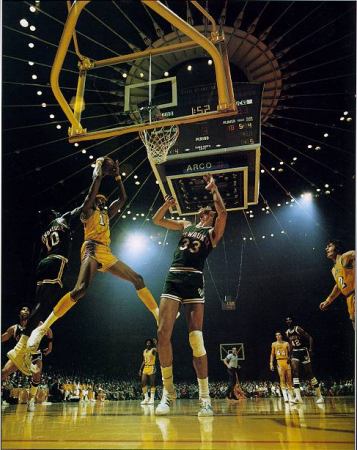
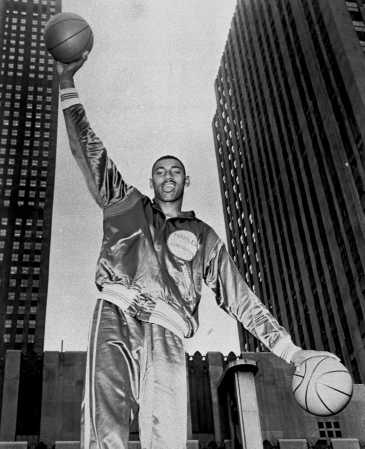
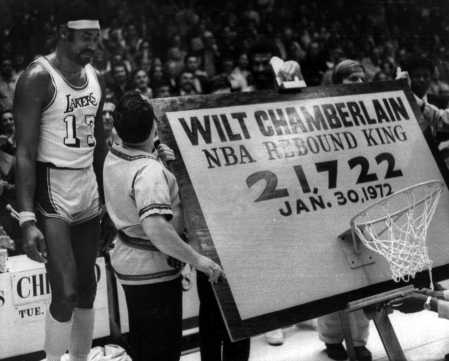
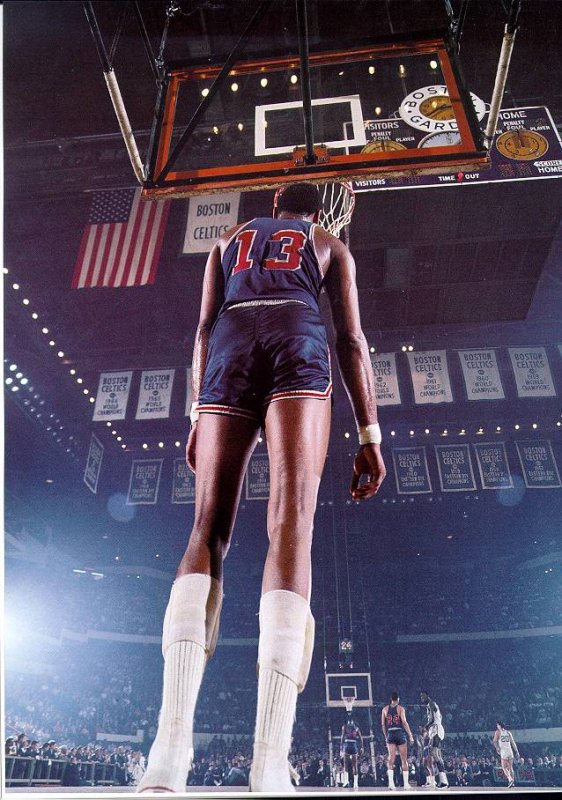
hvis man ønsker en kortere versjon av en biografi, kan man gå på denne siden:
http://myhero.com/myhero/hero.asp?hero=wilt_fredricksberg_academy_03




